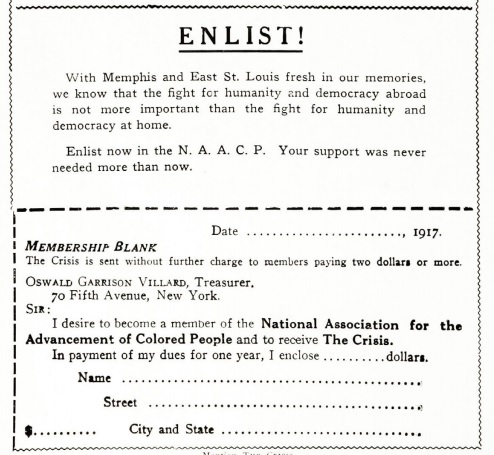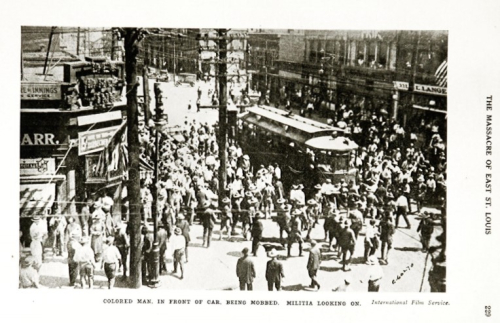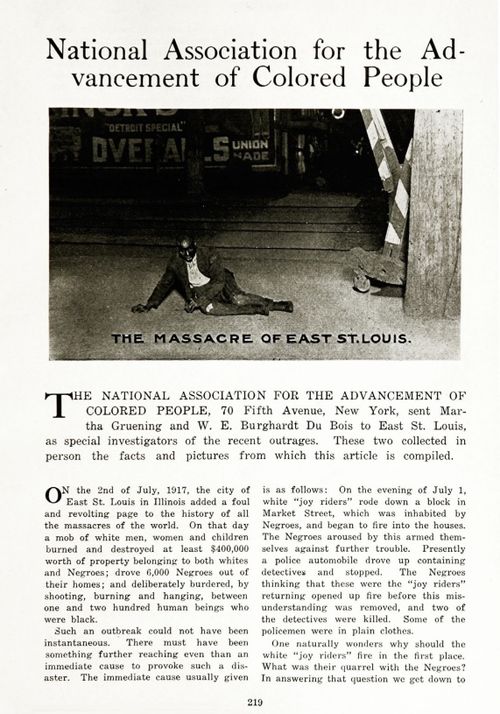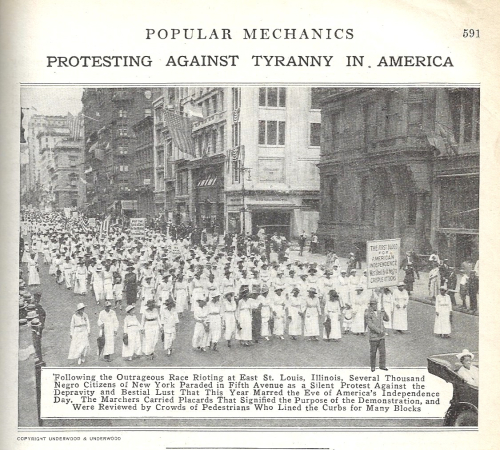JF Ptak Science Books Post 2752
The Crisis, a journal of the NAACP, called for attention and action in response to the terrible 2 July East St. Louis Riot and massacre in their issue of September 1917. The leadership published a long article detailing the background and the horrors of the event, which you can read if you follow the link. The back of the cover of the journal featured a plea for membership (actually calling for people to "enlist", much like the people doing so during WWI which the U.S. finally entered 6 April 1917 after nearly three years of European warfare) which was followed in a few pages by the details of the event.
Long story short, racial tensions in East St. Louis were increased due to northerly African American migration from the Southern states, causing anxiety among the whites on purely racial reasons as well as the belief that there would be stiffer competition for work. The main catalyst though seems to have been a strike at American Steel, the management hiring hundreds of Black workers to replace the White strikers. Tensions high, a carload of Whites drove into the segregated Black side of town and opened fire on a group of Black men. Shortly afterwards another car of Whites--this time including two policemen--made a similar tour of the area, the Blacks responding with gunfire thinking that it was another drive-by. The two policemen were killed, and then things escalated quickly and brutally, with tens of thousands of Whites turning out to ESL and rioting, beating, clubbing, shooting, and setting fire to buildings (while cutting the hoses of the fire department to ensure that the arson burned the buildings to the ground. Impartial eyewitnesses to the event reported that the National Guard and the police were in very large part unresponsive to the threatened population, and in many cases aided and abetted the rioting. In the end estimates ranged stating that 50-200 African Americans were killed and 6,000 made homeless, while later on a Congressional investigation reported that an accurate estimate of the murdered could not be made.

- Source: The Crisis, September 1917, vol 14/5, pp 218-238, via Marxists.org: https://www.marxists.org/history/usa/workers/civil-rights/crisis/0900-crisis-v14n05-w083.pdf

Weeks later on the 28th there was an extraordinary display of protest in The Silent Parade(s), the version in NYC beginning on 5th Ave and 57th Street:
- "To the beat of muffled drums 8,000 negro men, women and children marched down Fifth Avenue yesterday in a parade of "silent protest against acts of discrimination and oppression" inflicted upon them in this country, and in other parts of the world. Without a shout or a cheer they made their cause known through many banners which they carried, calling attention to "Jim Crowism," segregation, disenfranchisement, and the riots of Waco, Memphis, and East St. Louis."--Wikipedia
And this section is from the next article in The Crisis, from a leaflet describing the reason and the purpose of the parades:
The Silent Parade
[Source: Popular Mechanics, October 1917]
During the progress of the march circulars were distributed among the crowds telling of the purpose which brought the Negroes together. Under the caption, "Why Do We March? " the circular read, in part, as follows:
- "We march because by the grace of God and the force of truth the dangerous, hampering walls of prejudice and inhuman injustices must fall.
- "We march because we want to make impossible a repetition of Waco, Memphis, and East St. Louis by arousing the conscience of the country, and to bring the murderers of our brothers, sisters and innocent children to justice.
- “We march because we deem it a crime to be silent in the face of such barbaric acts.
- "We march because we are thoroughly opposed to Jim Crow cars, etc., segregation, discrimination, disfranchisement, lynching, and the host of evils that are forced on us. It is time that the spirit of Christ should be manifested in the making and execution of laws.
- "We march because we want our children to live in a better land and enjoy fairer conditions than have fallen to our lot.
- "We march in memory of our butchered dead, the massacre of honest toilers who were removing the reproach of laziness and thriftlessness hurled at the entire race. They died to prove our worthiness to live.
- "We live in spite of death shadowing us and ours. We prosper in the face of the most unwarranted and illegal oppression. " We march because the growing consciousness and solidarity of race, coupled with sorrow and discrimination, have made us one; a union that may never be dissolved in spite of shallow-brained agitators, scheming pundits and political tricksters who secure a fleeting popularity and uncertain financial support by promoting the disunion of a people who ought to consider themselves as one."
If you at all interested in this, help yourself to the link. It is very compelling reading.





Comments